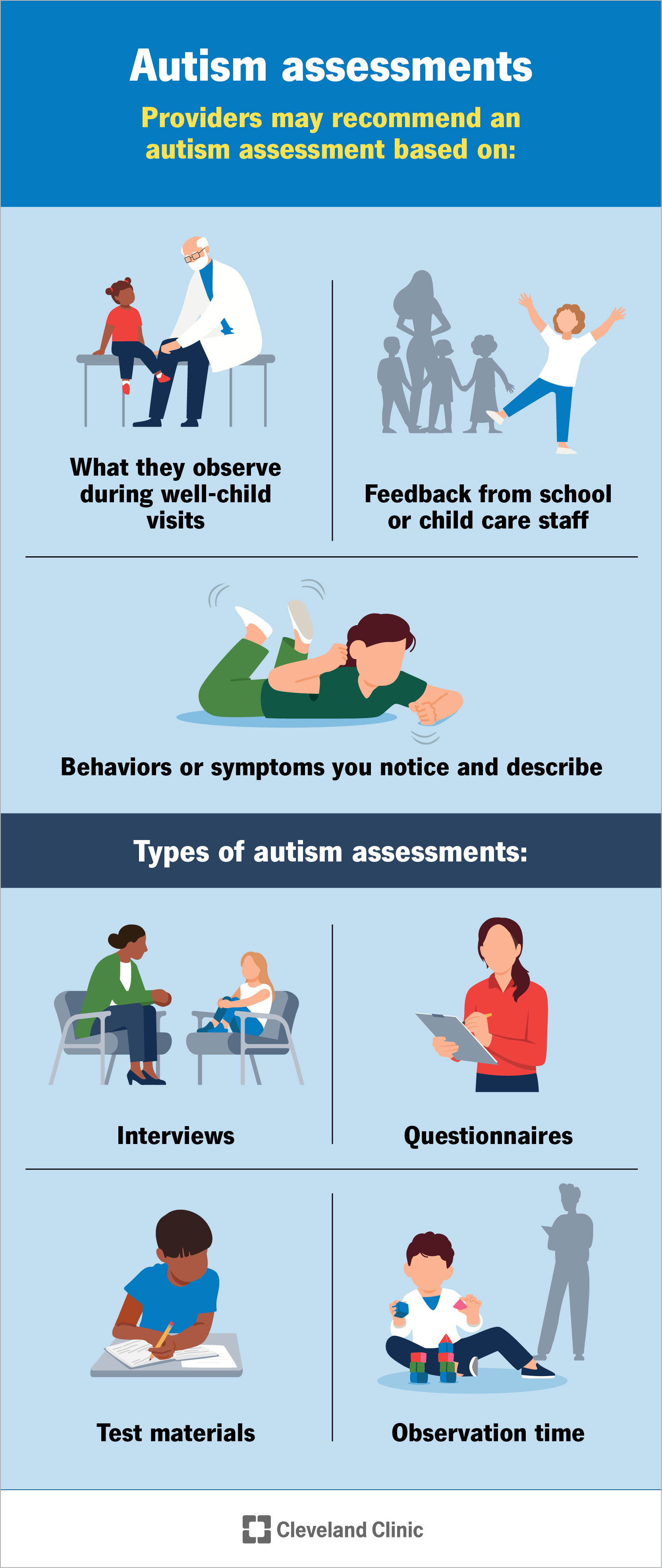Autism assessments come in many forms. While you might feel tempted to just take a test online, they’re no substitute for an expert touch. Healthcare providers are your best resource for getting tested. They can tell you which assessment tools can help you or your child get a diagnosis. And they can guide you on next steps.
Advertisement
Cleveland Clinic is a non-profit academic medical center. Advertising on our site helps support our mission. We do not endorse non-Cleveland Clinic products or services. Policy

Autism assessments are tools that healthcare providers use to diagnose autism spectrum disorder (ASD). The assessments are a key tool for diagnosing ASD during early childhood. But many of these tools can help adults get diagnosed, too.
Advertisement
Cleveland Clinic is a non-profit academic medical center. Advertising on our site helps support our mission. We do not endorse non-Cleveland Clinic products or services. Policy
Experts classify ASD as a developmental disorder because it starts in childhood. Common signs often include:
Pediatricians in the U.S. typically screen all children for autism during well checks. Pediatricians commonly follow guidelines from two organizations on when to screen. Those are the:
Research shows early diagnosis and treatment can help children with autism reach their full potential.
Providers may recommend an autism assessment based on:
Not all autism assessments are the same. Some are simple screening tools that providers use to determine whether a child needs further testing. Others are for making a full diagnosis.
Advertisement
The different assessment tools usually rely on one or more of the following:
Screening tools include:
Full autism assessment tools include:
When a provider is completing an autism assessment, they’ll probably use several of these tools and others.
One reason there are so many different assessment tools is that autism can look very different from person to person. And the tools themselves vary. Some are useful for screening by age. Others are best at uncovering specific symptoms or effects.
Autism has links to many other conditions, so it’s common for providers to test or screen for those, too. Some of the related tests and assessments your child’s provider might recommend include:
Autism assessments work a little differently, depending on the type and the tool used. Some assessments, especially screening tools, take only a few minutes. Your child’s provider may ask you questions or test your child’s reactions to certain things.
Full autism assessments usually take longer. Some can last for a few hours, or they might even take multiple sessions. That’s partly because autism shares many symptoms with other conditions. To diagnose autism, providers also have to rule out other conditions. It’s also because the assessments gather information about how autism affects you or your child specifically. That’s valuable for planning treatments and managing autism’s effects.
Advertisement
Autism assessments can have big differences depending on the type of assessment, the specific tool used and more. Because of that, the healthcare provider doing the assessment is the best person to tell you what to expect. They can also tell you what you need to do to prepare.
For childhood screening tests, you usually won’t need to prepare. Your child’s provider can do those during a regular well-child visit. Many of these involve asking you questions about your child or seeing how your child reacts to certain things. Screenings usually take 30 minutes or less.
Diagnostic autism assessments are more comprehensive. They can take up to several hours. Your provider may recommend doing it over multiple visits. They may also recommend that you prepare for these kinds of visits.
Some things they may suggest when the assessment is for your child include:
Your child’s provider can tell you more about what you should or might want to bring.
Your provider can typically tell you the results of an autism screening when they complete it.
Advertisement
Based on that screening, they may tell you the following about your child:
While a provider can make the diagnosis as early as 9 months, most cases don’t get a diagnosis until around age 4. But research still shows that most screening tools for diagnosing autism before age 2 are highly reliable.
When a diagnostic assessment confirms your child is autistic, their provider will also tell you about:
Experts often look for certain telltale symptoms that are autism-specific. Some examples of these include:
Advertisement
No, don’t rely on online tests. That includes medically validated ones like the Ritvo Autism Asperger Diagnostic Scale (RAADS) or Autism-Spectrum Quotient (ASQ). There’s no harm in taking these tests, but don’t take them as official confirmation.
A big reason for that is symptom overlap. For example, people with several neurodivergent conditions can score high on these tests. But that’s because of shared symptoms across conditions. Online tests can’t tell you if you have more than one condition. And they can’t tell you if you have a related genetic condition or another health concern.
While online tests aren’t good for diagnosing autism, they can still raise awareness. If taking one of these tests makes you suspect you’re autistic, you may want to talk to your primary care provider about getting diagnosed. They can either screen you for autism themselves or refer you to a specialist for testing.
Whether it’s for your child or yourself, an autism assessment can feel intimidating. It’s natural and understandable to want answers. But it’s also natural to worry about what the answers will mean for you.
But no matter what your situation, a healthcare provider can help you. Your child’s pediatrician or your primary care provider can start the testing process. And they can guide you on the next steps if testing finds anything. Their job is to support you through all of it.
There’s hope and caring for kids with autism spectrum disorder. At Cleveland Clinic, we design compassionate, personalized treatments for them.

Last reviewed on 11/11/2025.
Learn more about the Health Library and our editorial process.